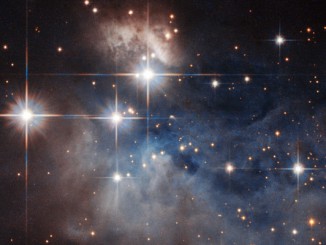
In the first observation of its kind, the Hubble Space Telescope has found helium in the atmosphere of a Jupiter-class exoplanet 200 lightyears from Earth. Another team of researchers, using Europe’s Very Large Telescope in Chile, has found an exoplanet, WASP-96b, with a cloud-free atmosphere, allowing them to detect sodium in levels similar to abundances on Earth.
WASP-96b orbits a star 980 lightyears away. It is similar in mass to Saturn and 20 percent larger than Jupiter. Astronomers had predicted that sodium exists in the atmospheres of such hot gas giants, but clouds would act to block such signatures.
“We’ve been looking at more than twenty exoplanet transit spectra,” said Nikolay Nikolo of the University of Exeter, lead author of a paper outlining the observation. “WASP-96b is the only exoplanet that appears to be entirely cloud-free and shows such a clear sodium signature, making the planet a benchmark for characterisation.
“Until now, sodium was revealed either as a very narrow peak or found to be completely missing. This is because the characteristic ‘tent-shaped’ profile can only be produced deep in the atmosphere of the planet and for most planets, clouds appear to get in the way.”
Co-author Ernst de Mooij of Dublin City University said WASP-96b “provide us with a unique opportunity to determine the abundances of other molecules, such as water, carbon monoxide and carbon dioxide with future observations” using both the Hubble Space Telescope and NASA’s much more powerful James Webb Space Telescope, scheduled for launch in 2020.
Jessica Spake, a Ph.D. student at Exeter, used Hubble to identify helium in the atmosphere of a planet known as WASP-107b some 200 lightyears away.
“Helium is the second-most common element in the universe after hydrogen,” she said in a release. “It is also one of the main constituents of the planets Jupiter and Saturn in our solar system. However, up until now helium had not been detected on exoplanets, despite searches for it.”
The discovery was made using a new technique to study the upper layers of an exoplanet’s atmosphere as it passes in front of its parent star as viewed from Earth. Earlier detections of an exoplanet’s extended atmosphere relied on ultraviolet and optical light. The new technique utilises longer wavelength infrared spectra.
“The strong signal from helium we measured demonstrates a new technique to study upper layers of exoplanet atmospheres in a wider range of planets,” Spake said. “Current methods, which use ultraviolet light, are limited to the closest exoplanets. We know there is helium in the Earth’s upper atmosphere, and this new technique may help us to detect atmospheres around Earth-sized exoplanets which is very difficult with current technology.”



